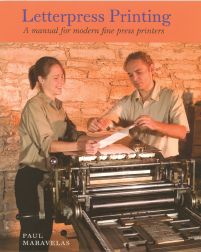Preface
The most beautiful printed text is produced with traditional letterpress, a process that gives the printer enhanced control as designs are developed, and guides the printer to legibility and a relaxed laying out of words. In letterpress, proofs show faithfully the play of light on the page, rather than on a computer screen or on some type of intermediate proof; letterpress printers can use this to their advantage to obtain the exact, finished feel that they want. When the impression in the paper is strong and noticeable, the effect is rich and sculptural. I have long believed that the three-dimensional effect makes letterpress printing easier to read because the eye focuses on letters that lie below the surface of the paper, leaving the paper surface itself outside of the focal plane. Preparing letterpress type is a slow, labor-intensive process; printing from type involves machinery and techniques on the fringes of today's world. Unlike type derived from computers and laser printers, hand-set type is expensive to acquire, and it takes up lots of room. The typical letterpress shop holds only a hundred fonts, while large institutional shops may have a thousand fonts. Further, the selection of type available from typecasters today is relatively limited. This apparent disadvantage has the benefit of compelling the designer to take a careful approach to spacing, color, ornament, and rule in order to vary and improve the appearance of his or her work. It also requires the printer to choose well when selecting faces for the shop.
Today's letterpress printer is like the fine arts painter, whose demise was predicted when photography was invented: instead of disappearing, the craft has enjoyed renewed enthusiasm in a fashionable niche.
Museums, art centers, and libraries promote fine printing and the book arts with new vigor; the public recognizes the carefully crafted book or broadside as something unique. Many colleges offer courses in letterpress printing as part of their curriculum in art or literature, and four book centers have become regional centers of activity: The Center for Book Arts in New York, founded in 1974; the Minnesota Center for Book Arts, founded in 1985; the Columbia College Chicago Center for Book and Paper Arts, founded in 1994; and the San Francisco Center for the Book, founded in 1996. While some supplies have disappeared from the market place, others have re-emerged. A New York tannery, for example, is now marketing parchment for letterpress made from goat, calf, and deer skins. A network of private typefounders, centered around the American Typecasting Fellowship, continues to cast type, and a few typefounders are designing new faces. One heavy platen printing press (the Kluge) is still being made, but proof presses and table top platens are only available on the used market. Fortunately, these machines are very durable and will last for centuries. If interest in the art continues, it is likely that small presses will again be manufactured.
This manual is based on my experience teaching at the Minnesota Center for Book Arts in Minneapolis. I hope that those learning the craft will be able to supplement the information here with good advice and actual demonstration by an experienced printer.
The use of type is traditional, and my approach to typography is traditional. But the information on printing in this manual is written for those working in letterpress today. The manual applies the measurements used in the United States and refers to the supplies available here. Two glossaries in the back of the book will explain unfamiliar terms. One lists words related to paper, and one lists words related to printing.

